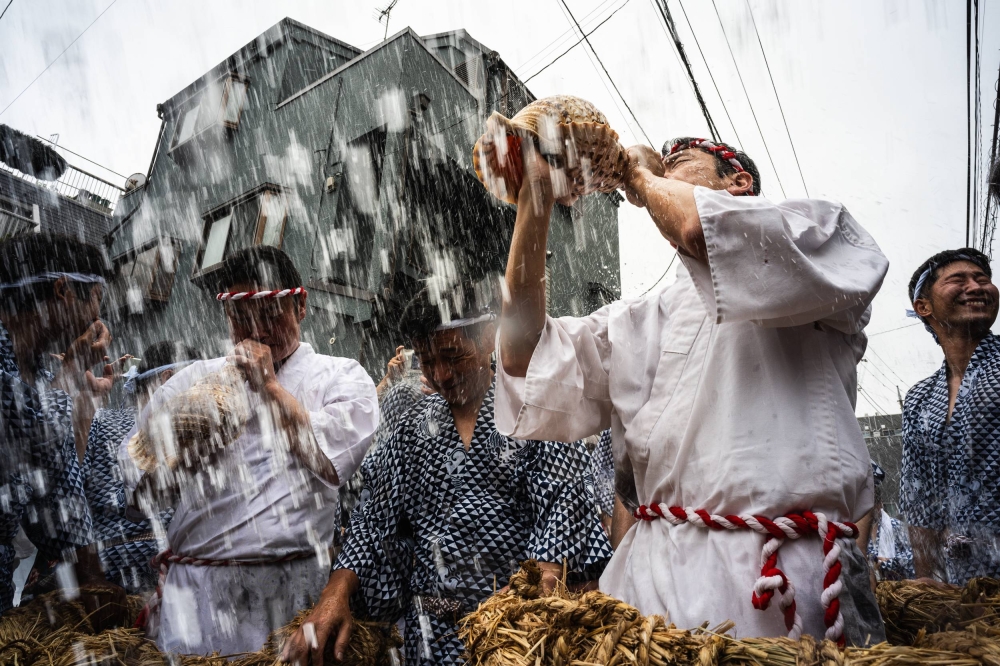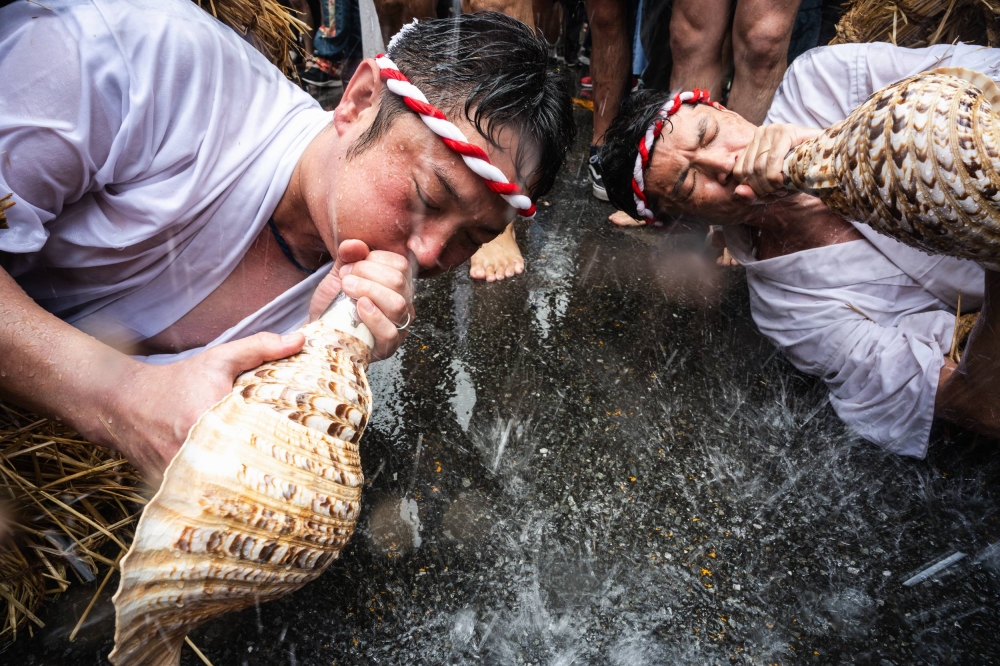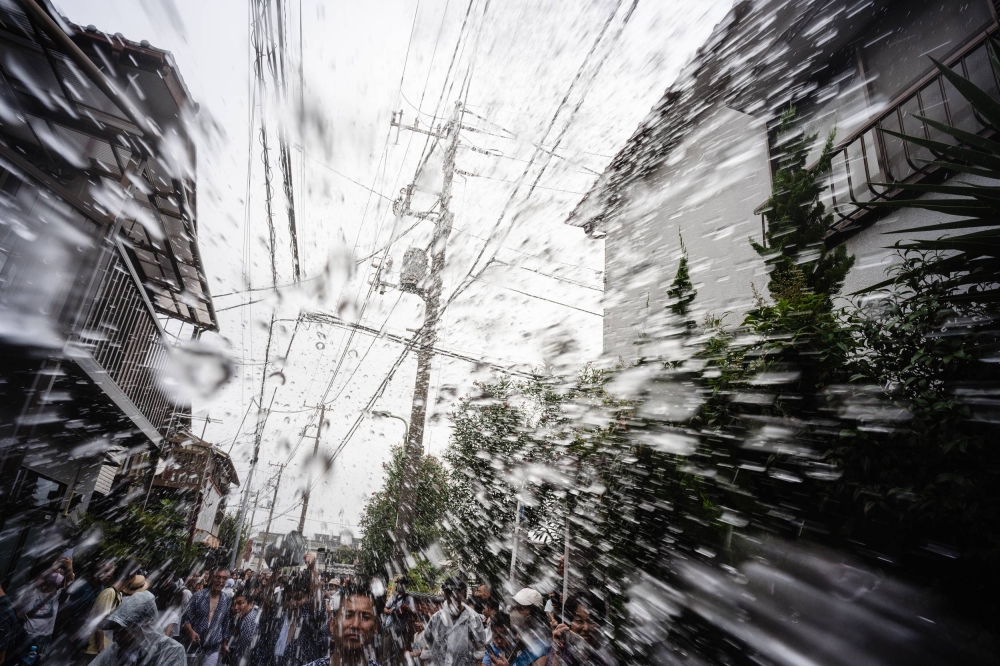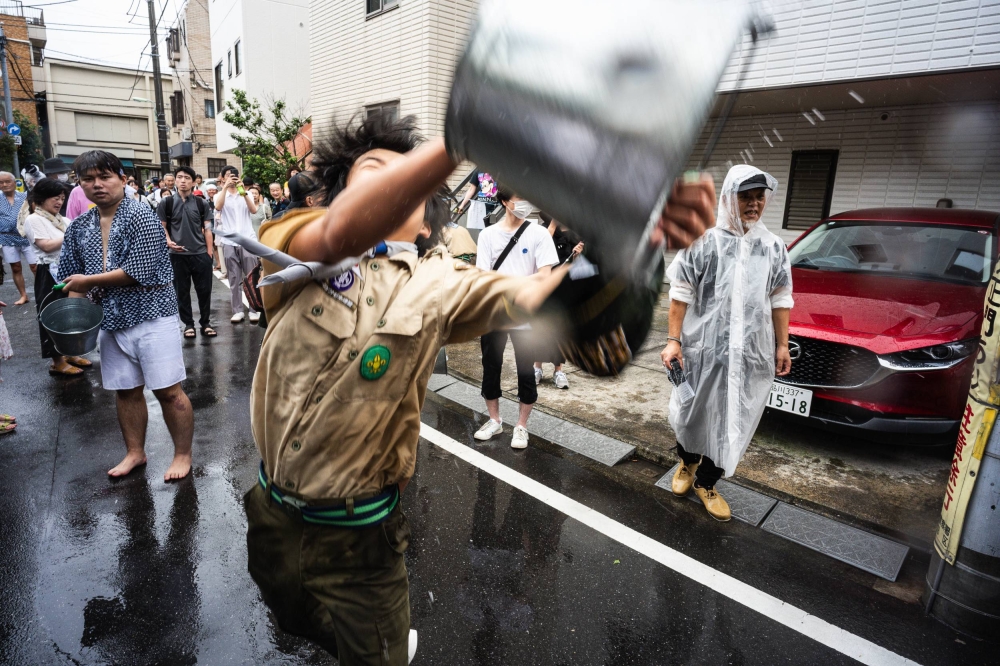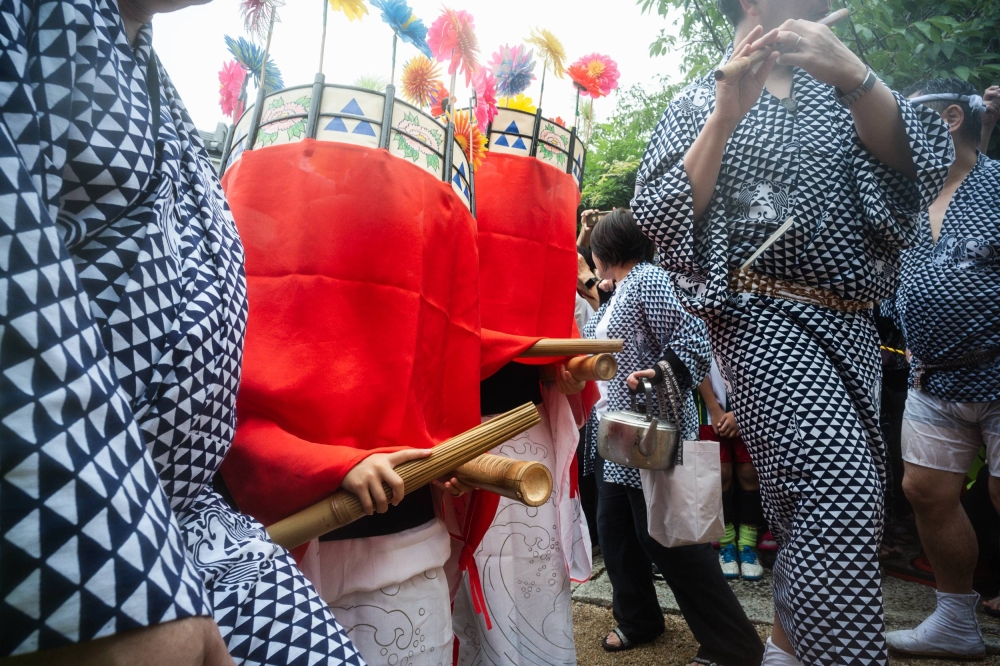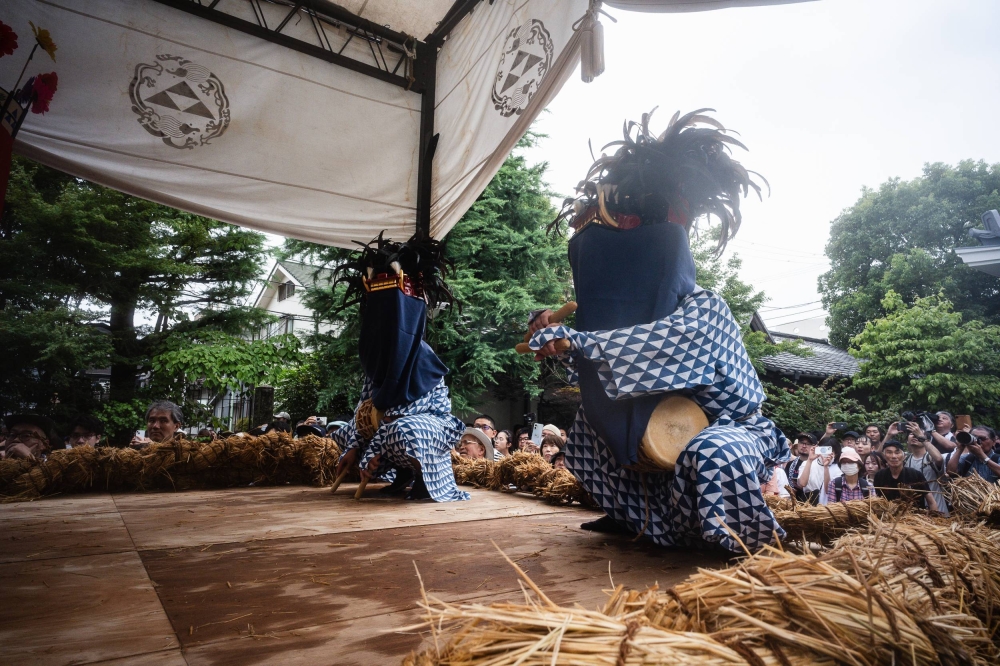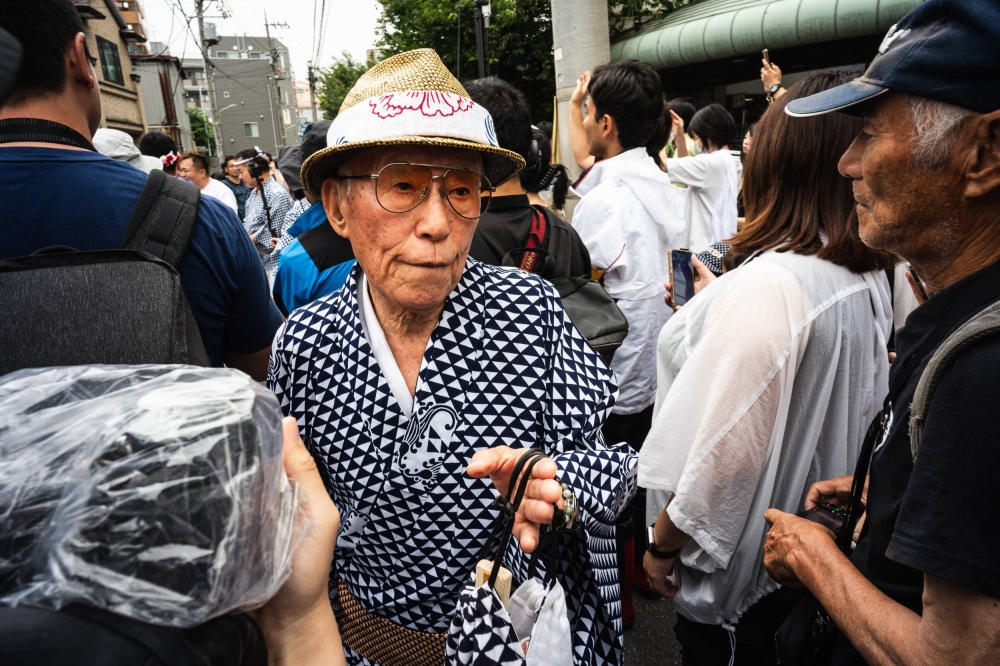Boiling Point
As climate extremes intensify, Japan embraces ancient weather rituals
It’s a muggy, overcast afternoon in mid-July, and two men scrunched into barrel-shaped containers made of straw are lying on the asphalt, blowing into conch shell horns as if their lives depend on it. Happi-wearing locals relentlessly drench the two with buckets of water and haul them a few meters at a time toward the gates of Gonshoji, a Buddhist temple nestled in a quaint corner of Tokyo’s southern Ota Ward.
This isn’t some bizarre form of punishment but a 700-year-old folk ritual born out of a desperate plea to alter the course of nature’s meteorological whims — an ancient tradition some are turning to as Japan’s weather grows more intense and erratic due to climate change.
“During a severe drought in 1321, suffering villagers begged the second-generation priest of our temple to pray for rainfall,” says Yuya Hojo, the deputy chief priest of Gonshoji.
“The ritual succeeded, but then two years later rain continued for weeks at a time and he was asked to make it stop. That’s the origin of Mizudome-no-mai (dance to stop the rain).”
For centuries, such folk beliefs and customs have offered comfort in the face of the often deadly natural calamities that plague Japan: droughts, epidemics, earthquakes, torrential downpours, flooding and extreme heat, to name a few.
And with the mercury already having risen to scorching levels this season — this summer is expected to be one of the hottest on record — these timeworn rituals have moved back into the spotlight, providing solace and refreshment to those exhausted from boiling temperatures and draining humidity.
“I feel like we’re experiencing something similar to what the villagers went through 700 years ago,” says Hojo, whose mother is the current chief priest of the temple, the 24th in line.
“Abnormal heat and sudden, fierce downpours — we’re seeing both. Those people at the time must have been greatly troubled by the phenomena and sought salvation.”
Come rain or shine
Folk festivals and traditions in Japan closely reflect their home region’s climate and topography.
Before being developed into a residential and commercial neighborhood in Ota Ward, Omori was a thriving fishing village facing Tokyo Bay, known for its cultivation of nori. Lying in the Tama River delta, however, the area housing Gonshoji has historically suffered from poor drainage leading to frequent water damage.
According to the Mizudome-no-mai preservation association, up until the 1940s it was common to wake up and find geta missing from entrances of homes after they were swept away by a night of heavy rainfall.
While rainmaking rituals were performed on occasion, prayers were offered more commonly to stop the rain. The tradition was on the verge of being lost, however, when dancers handing down the folk art perished during World War II.
“I feel like we’re experiencing something similar to what the villagers went through 700 years ago.”
Yuya Hojo, the deputy chief priest of Gonshoji
“Mizudome-no-mai itself nearly faced the same fate, but it was revived in 1954 after the war and designated as an intangible folk cultural property of Tokyo in 1963,” says Takashi Barada, a local elder and the chairman of the preservation association.
Nevertheless, the ritual is considered a kisai, or “peculiar festival,” drawing not only neighboring residents but also fans of Japan’s more obscure festivities.
The men rolled up in the straw barrels, for example, actually represent dragons, considered gods of water. The pails of water showered on them — and also over bewildered crowds of onlookers — are symbolic of rain, and the blowing of the conch horns are interpreted as dragons’ joyous roars.
This procession and rainmaking ritual, called the “michiyuki,” begins near a local junior high school and continues 150 meters down the street toward Gonshoji.
The parade eventually arrives at a stage within the temple grounds. The straw dragons resist being hoisted onto the platform, as they know their coils will be unbound, thus disempowering them. They eventually succumb, signaling the beginning of the Mizudome-no-mai.
Accompanied by two flower hat bearers, three dancers each dressed as a red female lion, a black male lion and a younger male lion perform on stage, their moves synchronized to flutes and singing as they pray for the precipitation to cease.
“I remember observing the ritual during my childhood, but the scale was much smaller back then,” says Hiroshi Narushima, another member of the preservation association who was born and raised in the district.
“Rainmaking rituals are quite common, but I hear those to stop the rain are very rare.”
Disasters and character
Lafcadio Hearn (1850-1904), the renowned writer, translator and teacher known for introducing Japanese culture and literature to the West, wrote that the Japanese psyche is influenced by the frequent disasters that strike the nation.
“When one reflects that for thousands of years Japan has suffered (natural disasters),” he wrote in an article published in 1894 titled “Earthquakes and National Character,” it is difficult to believe that “such extraordinary conditions have had no effect upon national character.”
There are said to be around 300,000 festivals held across Japan every year, from major events drawing millions to tiny village rituals hosted by local shrines and temples. Most, if not all, are performed in tribute to the gods and are often closely associated with the nation’s four seasons and weather.
And while the graying, shrinking population has seen many smaller traditions vanish due to a lack of successors, these festivities remain an integral part of society, providing a sense of solidarity and shared heritage within neighborhoods.
Akihiro Hatanaka, an author and editor specializing in Japanese folklore, says that, historically, the amount of rain affecting crop growth was a major concern for Japan’s agrarian society.
“Droughts hindered harvests, while heavy or prolonged rainfall caused flooding, severely disrupting farmers’ livelihoods,” he says.
“In response, the imperial court and shogunate offered sacred items at shrines and sought rain by having Buddhist monks perform rituals known as amagoi(rainmaking) or higoi (sun-making).” Unlike rainmaking, sun-making rituals such as Mizudome-no-mai prayed for clear skies and the cessation of rain.
Throughout the nation, various gods of water have been enshrined to govern rainfall.
“Rainmaking rituals are quite common, but I hear those to stop the rain are very rare.”
Hiroshi Narushima, preservation association member
Kyoto’s Kifune Shrine, a popular tourist destination, is one such institution. Located at the source of the Kamo River, the shrine venerates Takaokaminokami, the deity in charge of overseeing water supply and rainwater provision. On March 9 every year, the shrine hosts a rainmaking festival in hopes of bringing moderate rainfall and abundant harvests throughout the year.
Another shrine known for its reputed ability to control rain through prayer is the Niu-gawa Kamisha in Nara Prefecture. Considered the birthplace of shinme(divine horse) and ema (votive plaques), it is believed to have been the first place in Japan where horses were raised for offerings — a black horse for rainmaking and a white horse for fine weather prayers.
One of the largest rainmaking festivals in Japan takes place in the city of Tsurugashima in Saitama Prefecture. Known as the Suneori Amagoi, the event features a colossal dragon god constructed from bamboo and straw. Measuring 36 meters in length and weighing 3 metric tons, the mythical beast is borne through the city streets by around 300 men.
“The ritual dates back to the Edo Period (1603-1868) when a drought devastated crops,” says Anju Munakata, an official at the city’s cultural properties sorting office.
The oldest record pertaining to rainmaking ceremonies in the region was found in a document from 1813, where related expenditures are mentioned. Subsequent historical documents from the years 1848 and 1862 also include descriptions related to the costs associated with rainmaking ceremonies.
Due to the decline in full-time farmers who traditionally carried out the ritual, the ceremony ceased after 1964. In 1975, however, local residents of the Suneori district organized a preservation society, reviving the ritual the following year. Currently, it takes place once every four years, with the next festival coming up on Aug. 4.
“I hear the basic format of the ritual hasn’t changed since olden times,” Munakata says, “and in recent years the event has been drawing more and more people.”
A dance to stop the rain
July 15, the day the Mizudome-no-mai ritual was performed this year, is the Marine Day national holiday. That day also happened to see contrasting weather across Japan: Heavy downpours affected some areas, while others experienced their hottest day in 108 years, encapsulating the extremes witnessed so far this summer.
In Gunma Prefecture, a popular waterfall known as the Fukiware Falls saw its footpath flooded, stranding 22 people including two children after they lost their escape route in a matter of seconds due to rapidly rising water levels. They were all eventually rescued.
On Kyushu, some areas received intense rainfall exceeding 50 millimeters per hour, prompting the Japan Meteorological Agency (JMA) to issue a strong warning about landslides, flooding in low-lying areas and increased river levels.
In Naha, temperatures climbed above 35 degrees Celsius for three consecutive days for the first time since 1916.
Back at Omori, crowds gathered to observe Mizudome-no-mai as children with buckets indiscriminately sprayed water on onlookers. Television crews, photographers and reporters covering the event weren’t spared from the onslaught, their clothes and gear getting thoroughly soaked amid the festive mayhem.
In most of Japan, tsuyu, or the rainy season, typically lasts from the beginning of June to mid-July, but this year it was delayed for 14 days in the Kanto-Koshin region that includes the capital. On Thursday, the JMA announced that tsuyu appears to be over, one day earlier than usual.
“Well, it didn’t rain today but even if it did, the ritual is supposed to stop it,” Barada, the head of the preservation association, says as he looks up at the gray sky.
Last year was Japan’s hottest year on record, mirroring a global trend.
The World Meteorological Organization’s “The State of the Climate in Asia 2023” report highlighted an accelerating rate of key climate change indicators including surface temperature, glacier retreat and sea level rise, phenomena it said will have major repercussions for societies, economies and ecosystems.
“The report's conclusions are sobering,” WMO Secretary-General Celeste Saulo said in a press release. “Many countries in the region experienced ... a barrage of extreme conditions, from droughts and heatwaves to floods and storms. Climate change exacerbated the frequency and severity of such events.”
Last year’s extreme weather was partially fueled by El Nino, a climate pattern where sea-surface temperatures of the equatorial Pacific Ocean become unusually warm. While the JMA announced on June 10 that the phenomenon is considered to have ended, it typically exerts its greatest influence after it finishes.
Anticipating rising temperatures, Prime Minister Fumio Kishida announced last month that the government will temporarily reintroduce subsidies for utility bills.
“We will provide emergency support to endure severe heat by subsidizing electricity and gas bills for the months of August, September and October,” he said.

Hojo, the deputy chief monk at Gonshoji, says that while Mizudome-no-mai originated as a ritual to both start and stop rain, it’s ceremonial nature evolved when the sixth-generation chief priest at the temple changed its affiliation from Tendai, one of two major esoteric sects of Buddhism in Japan, to Jodo Shinshu, a school of Pure Land Buddhism.
“Now it’s performed more as a dance expressing the gratitude and joy of the people at that time,” he says.
Even still, residents who have kept the ceremony alive seem to accept the ritual’s special powers.
Speaking to a television broadcaster while lion dancers performed in the background, preservation association member Narushima articulated his thoughts on the event’s significance.
“We dance in the hope that disasters involving rain will end soon for people in other regions as well.”

